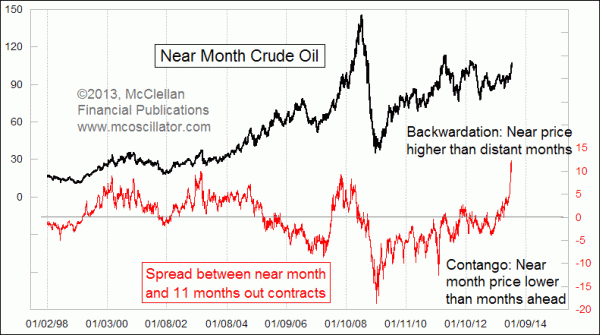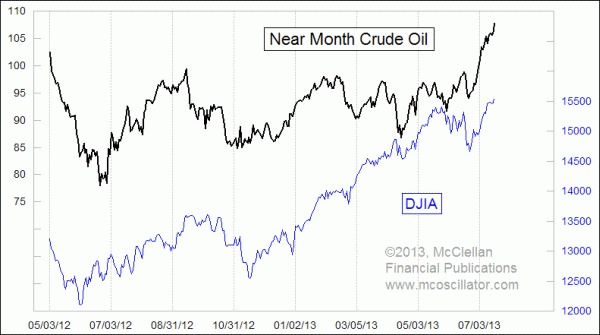Huge Backwardation In Crude Oil

Free Chart In Focus email
Delivered to you every week
Crude oil production in the U.S. is now at its highest level in years. And American motorists are using less fuel per capita than at any time in the past 30 years. So why the heck are oil prices zooming up so high right now?
Actually, not all oil prices are zooming. The near month futures contract for light sweet crude oil right now is the August 2013 contract, which settled on July 18 at $108.22 per barrel. But looking out 11 months into the future to the July 2014 contract, we find that it closed at just $95.56. That is a huge difference, and it says that oil futures traders are not willing to bet on the current month's high price continuing into the future. In other words, it is a temporary anomaly.
Such anomalies can contain important information. This week's chart looks at the raw price spread between the near month contract and the contract that is 11 months out. When the near month contract is priced lower than the out months, that condition is known as "contango". In commodities like gold and silver, contango is the norm since the available supply consists of not just the mining production but also all of the bullion sitting in warehouses and safes around the world.
But because oil is so much more expensive to store than gold is, there is not the same sort of standing inventory available to remediate temporary supply-demand disruptions. So oil prices can move to very large conditions of contango, or to the opposite condition known as "backwardation" like we are seeing right now.
The normal market-based remedy for a large contango condition is for speculators to buy the cheaper commodity in the spot market and put it into storage, then sell a distant month futures contract to take advantage of the price difference between near month and out month pricing. That can be a profitable game if the amount of that price spread is sufficient to pay for both the storage costs and the cost of capital. So there is a natural limit to how big a contango can get, assuming that there are storage facilities available.
The way that a backwardation condition gets resolved is either for consumers to use less of the high priced commodity now, or for producers to accelerated production to meet the higher current spot price rather than saving that production for later when prices are not as attractive There are limits on how quickly such production increases can be implemented, but a $12/barrel difference between the current price and that of 11 months out can pay for a lot of improvements to production capacity. There are also limitations on how much demand can be reduced due to higher prices. People still have to drive to work, and they still want to take the Winnebago to Yellowstone.
This current spread between the August 2013 and July 2014 contracts is the biggest raw price spread in years, although as a percentage of the current price we have seen more severe backwardation at other times. The message to take from this is that the current pop in near month futures prices is not likely to continue much farther, with the rubber band already stretched.
And one additional message to take from this concerns the stock market. In recent months, there has been a strong correlation between the movements of oil prices and the movement of the DJIA.

So if near month crude oil prices are stretched enough relative to far month prices to merit a pullback, then the implication is that the stock market ought to pull back in sympathy.
Tom McClellan
Editor, The McClellan Market Report
Feb 25, 2011
Oil Spike Eases Big Contango |
Oct 05, 2012
Americans Really Are Using Less Gas |
Mar 15, 2013
Canada, Mexico, and Oil Prices |